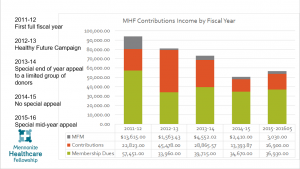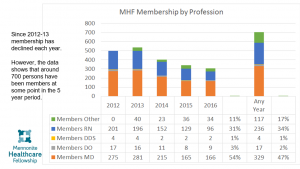Mennonite Health Journal
Articles on the intersection of faith and health
A Funding Model for Mission
Paul D. Leichty, MHF Executive Director
Mennonite Health Journal, Vol. 18, No. 4, August 3, 2016
Over the course of the summer months, the Board has been sharing a strategic plan for the ongoing development of Mennonite Healthcare Fellowship (MHF). The plan consists of four major points, two of which have already been shared.
- The mission of MHF was outlined in the first point which calls for a more focused approach to the mission of MHF as well as more consistently using the language of “mission” for the overall work of the organization. Instead of trying to do everything, the following themes have been identified at the heart of MHF’s mission: (1) Mutual support, (2) Education, (3) Mentoring, and (4) Mobilization for service. The goal is to support each other in the integration of our Christian faith and our professional life. To do that, MHF will use the resources of our age of technology and promote collegial interaction, educational events, and mentoring relationships, all of which mobilize us for compassionate Christian service.
- A Missional Budget Plan forms the second point in the strategic plan. This has to do with consolidating the assets inherited from Mennonite Medical Association (MMA) and Mennonite Nurses Association (MNA) as well as funds given to MHF. Consolidating the assets of MHF means no longer separately tracking separate “mission” funds which belong to MHF. This makes all funds available for the total mission of the organization. It also provides for a unified budget, simplified bookkeeping, and less costs for administration and accounting.
This brings us to the third point in the strategic plan. Consolidating assets on its own does not address the yearly budget situation. To do that, the Board looked at the funding model of the organization. For the first five years, MHF has relied on a funding model similar to the one used by both MMA and MNA. This is primarily a membership dues model in which the work of the organization is supported by persons who become “members” of the organization by paying a certain amount each year in “dues.”
However, the membership dues model has not remained pure. Over the years, even back to MMA/MNA days, the model has been modified when a dues structure was not meeting the financial needs of the organization.
- The first step has been a tiered model of dues in which persons with greater financial means paid more. Students, volunteers, and retirees paid a reduced rate. Those who could afford it paid for a “Sustaining Membership” at a higher rate than the “Regular Membership.”
- When even that wasn’t enough, the second step has been encouraging those who were able to give additional contributions for operations and even more to one or more “mission funds.”
However, from a legal standpoint, all “dues” and “additional contributions” for whatever designated fund were considered donations and thus tax deductible under U.S. federal income tax guidelines. Thus, MHF inherited and has continued to use a membership dues model which has been increasingly modified toward a contributions model to sustain the organization.
Two graphs illustrate the results of using this model over the five-year history of MHF. In the first, we see contributions income over the five-year period by fiscal year. The second is a chart of membership during that same time period. (Double-click on each image to see a larger view.)

 In both cases, an overall gradual decline is noted. The conclusion is that previous members of MMA and MNA still have interest in MHF but are no longer steady in their yearly giving, but in many cases, dropping out due to age or death. At the same time MHF is attracting new members, but not the numbers that were projected from a wider a variety of professions and not many in 20’s and 30’s.
In both cases, an overall gradual decline is noted. The conclusion is that previous members of MMA and MNA still have interest in MHF but are no longer steady in their yearly giving, but in many cases, dropping out due to age or death. At the same time MHF is attracting new members, but not the numbers that were projected from a wider a variety of professions and not many in 20’s and 30’s.
In the current fiscal year, we are starting to reverse the decline in giving by initiating additional fundraising appeals during the year. Thus, the third point in the strategic plan calls for MHF to continue the shift from a member dues funding model to a contributions model in support of the refocused mission outlined in point number one. In some ways, the shift is subtle, but in many other ways, it is highly significant.
It is important to note that legally speaking, MHF has never been a membership organization. Ultimate control of the organization rests with the Board of Directors and that Board is self-perpetuating. For practical purposes, however, we have been using the language of members to define who is able to serve on the Board as well as how MHF is growing (or shrinking) as an organization. That will not change; MHF will still talk about members, those who support the organization.
However, MHF will no longer use the language of “dues.” Instead, we will try to consistently use the language of “contributions.” We will continue to suggest levels of giving according to life stages and financial ability but in the end rely on individuals to self-select their level of giving. In addition, contributions can be made at any time of year. It is likely that MHF will continue asking for contributions at these key times:
- Beginning of the fiscal year (September)
- Holiday season (November/December)
- Spring (April)
- End of fiscal year as needed (August)
Thus, anyone who makes a contribution during the current or past fiscal year will be considered an active member. If two years pass without a contribution, the person will be considered an inactive member.
Focusing on contributions instead of “dues” also has the following implications for me as an individual member of MHF:
- It shifts the focus from myself to others, from what I as an individual member (who has paid dues) receive as a benefit from the organization to how I can contribute to the overall mission of the organization which I support.
- It allows me to give freely to the work of MHF as I am able. For example, I am not limited to either $85 for Regular Membership or jumping up to $300 for Sustaining Membership. I can give $100, $150, or $500 as I see fit.
- It allows me to contribute year by year at a different level if my financial situation changes.
- It allows me to give more than just once a year according to my interest at the time and the needs communicated by MHF to fulfill its mission.
- The simple change of language also implies that giving to MHF is less about an obligation and more about joyfully participating in a common mission!
- It means I don’t need to think about or ask, “Have I paid my dues yet this year?” Instead, I can give freely and cheerfully!
The Board sees the shift from dues to contributions as a strategic step to encourage greater participation and greater financial support according to the ability and interest of each prospective member. As always, we value your comments and suggestions.
About the author
 Paul D. Leichty, M.Div. is Executive Director Emeritus, having served as the first Executive Director of Mennonite Healthcare Fellowship (MHF) from Sept. 2011 through May 2020. Paul has served as a pastor, church musician, computer support person, disabilities advocate, and administrator/organizer of a number of church-related ministries. Paul also served as Executive Director of Congregational Accessibility Network which was transformed in 2022-23 to Disability Ministry Network. He is a member of Agape Fellowship of the Mennonite Church in Williamsport, Pennsylvania where he lives with his wife, Twila Charles Leichty.
Paul D. Leichty, M.Div. is Executive Director Emeritus, having served as the first Executive Director of Mennonite Healthcare Fellowship (MHF) from Sept. 2011 through May 2020. Paul has served as a pastor, church musician, computer support person, disabilities advocate, and administrator/organizer of a number of church-related ministries. Paul also served as Executive Director of Congregational Accessibility Network which was transformed in 2022-23 to Disability Ministry Network. He is a member of Agape Fellowship of the Mennonite Church in Williamsport, Pennsylvania where he lives with his wife, Twila Charles Leichty.
